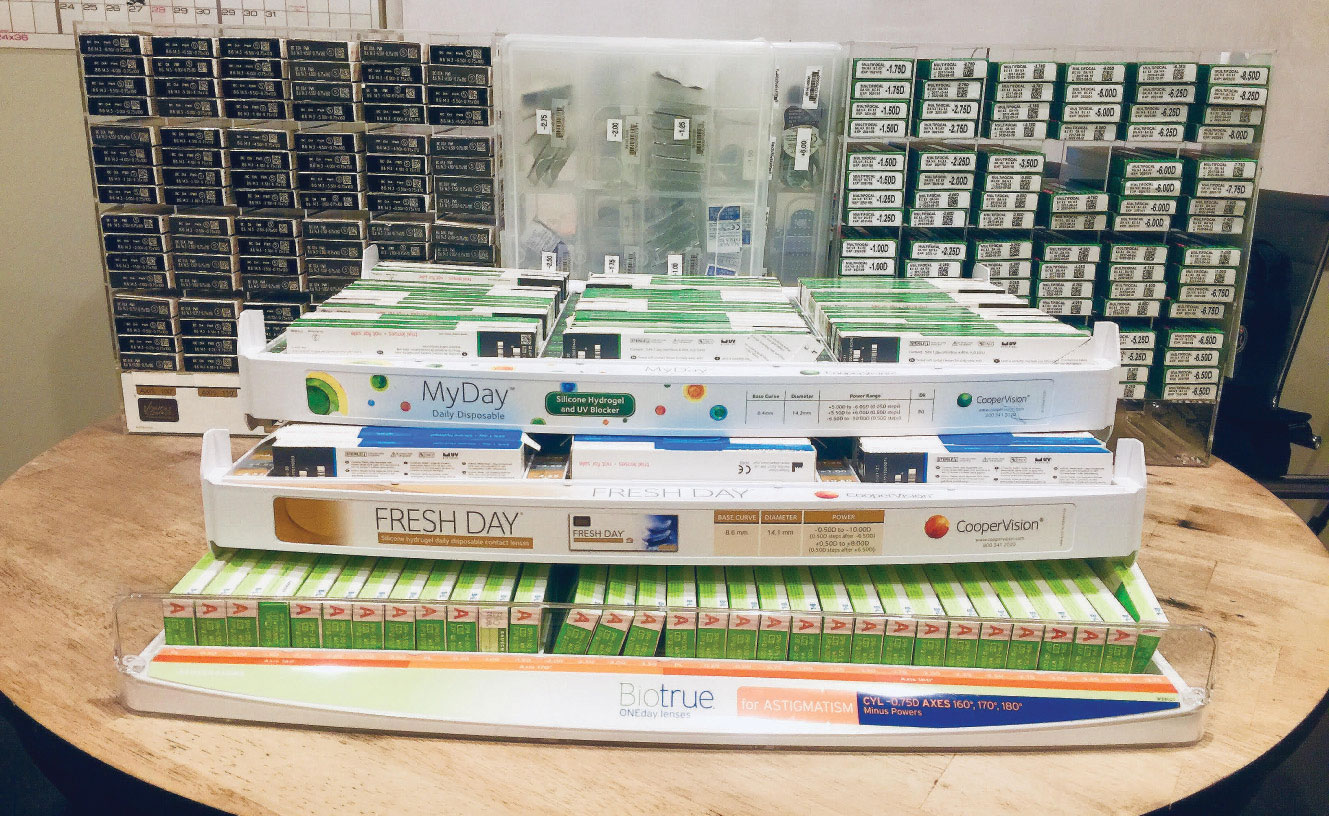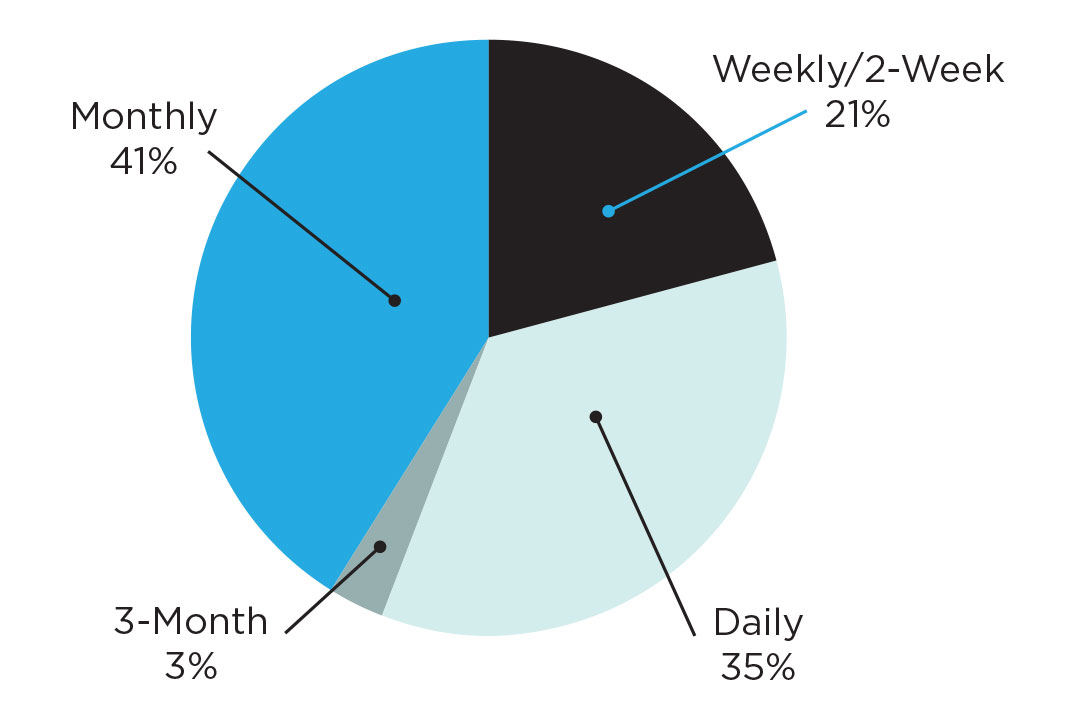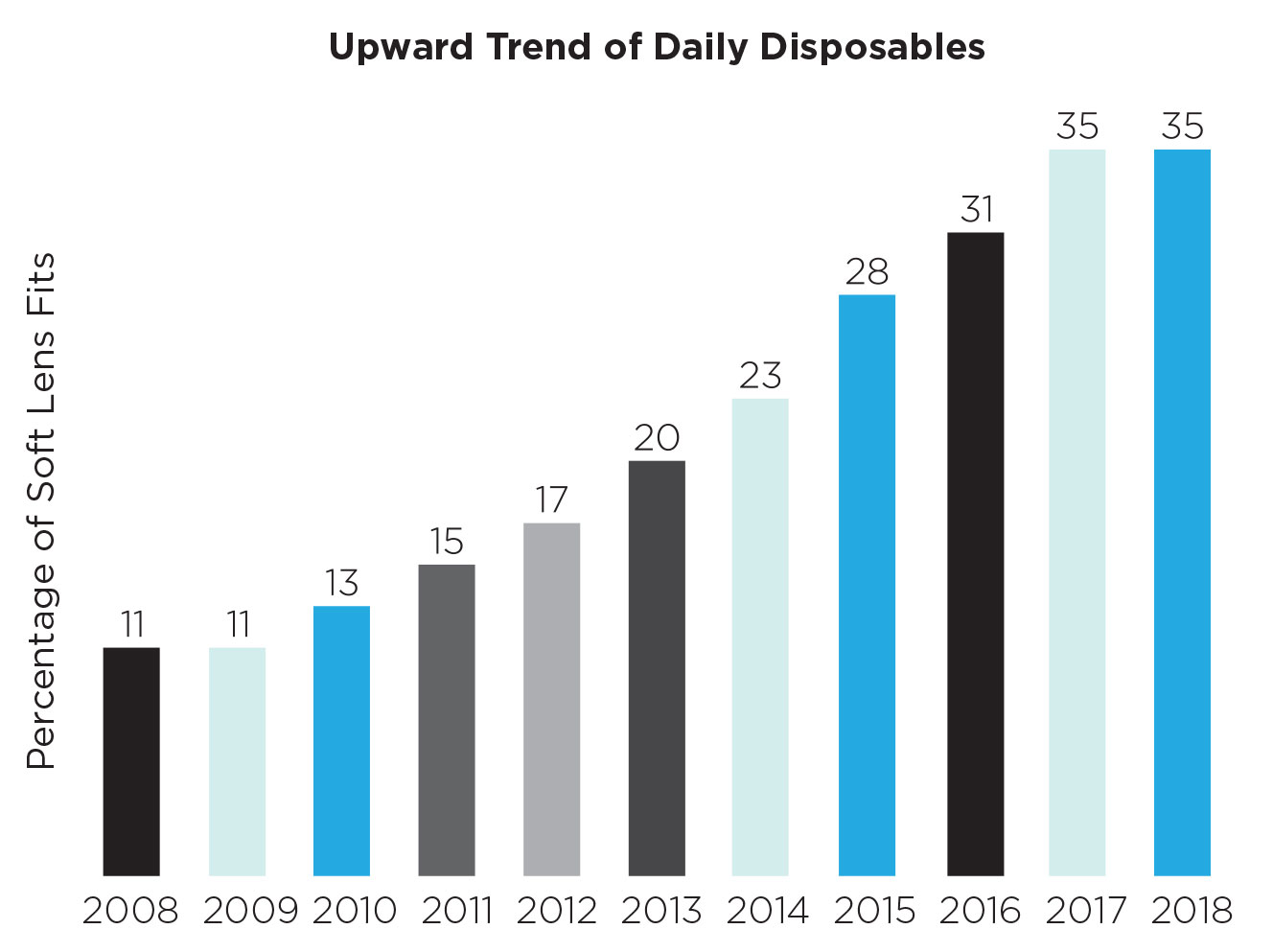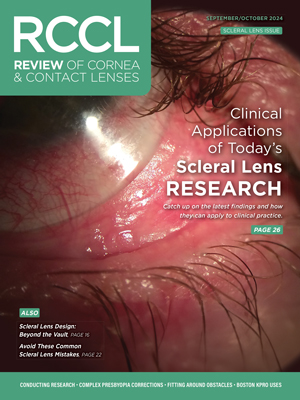When a patient is in our chair expressing an interest in contact lenses, what drives our recommendation decisions? The always-evolving nature of lenses can make weighing our options an overwhelming and tedious process, but our patients rely on our expertise as health care professionals to help select the best lens for them.
We’ve reached a consensus with our colleagues that daily disposable contact lenses produce the healthiest ocular results. In our practices, daily disposable wearers tend to be more compliant and have lower incidences of microbial keratitis, contact lens-associated red eye, corneal infiltrates and contact lens-related dryness. Further, these users have almost no incidence of solution toxicity or solution-related adverse responses. Most eye care providers agree that the daily disposable modality is optimal, so why don’t our prescribing habits reflect this belief, and why does the United States lag behind many other countries in daily disposable prescribing rates?
 |
| A sample of the daily disposables we use in our offices. |
Consider Global Prescribing Habits
Over the past 10 years, there has been a consistent increase in the percentage of daily disposable fits and refits. In the United States in 2008, daily disposables only made up 11% of soft lens fits while monthly and one-week/two-week modalities accounted for 40% each.1 In 2018, however, daily disposable lenses increased more than trifold to 35% of soft lens fits, one-week/two-week lenses decreased to 21% and monthly lenses moved up to 41%.2 Internationally, the story is the same for the most part: daily disposable contact lenses accounted for 18% of new soft lens fits in 2008 and increased to 32% this past year.3,4 There are a few countries that have fully embraced the daily disposable modality and stand out among the rest: Japan at 57%, Australia at 64%, Norway at 63% and Denmark and Finland each at 71% of daily disposable lenses as new soft fits.
Without being immersed in the health care industries of the countries excelling in daily disposable prescribing, it is difficult to determine how and why they are able to prescribe these lenses at a much higher rate. These countries are generally regarded as some of the more health-conscious countries, so perhaps it is this mindset that drives patients to prioritize the safest and healthiest lenses available, which happen to be daily disposables.
We believe there are a few contributory factors in the industry that have driven this upward trend in daily disposable lenses over the last decade. In the early 2000s, contact lens solutions were heavily marketed. Around 2008 or 2009, we noticed that representatives from solution manufacturers were visiting our offices less frequently. At that same time, our industry partners were rolling out daily disposable lenses and putting more time and effort into producing and promoting these products. As parameters expand, materials and proprietary hydrating compounds evolve, and ease-of-fitting improves, the daily disposable market is gaining all the tools it needs to take off.
 |
| The distribution of soft lens fits in the United States in 2018.2 |
Prescribing Shortcomings
Recently, a colleague started a thread on social media asking why doctors don’t prescribe daily disposable lenses. The most common responses included unavailable parameters, increased cost to the patient and nonexistent or improper education.
Parameter Constraints
Spherical daily disposable lenses span an incredible range and are available from +8.00D to -12.00D. Toric lenses have around-the-clock axes available up to -1.75D of cylinder and many options in -2.25D of cylinder. For presbyopic patients, multifocal daily disposables are available from +6.00D to -9.00D. Soon, toric lenses in -2.75D of cylinder and toric multifocals will be available, further expanding the patient populations we can fit. With such a wide array of lens options, we can easily find daily disposable lenses to correct a vast majority of our patients. That being said, for patients who are highly hyperopic or myopic, or who have oblique astigmatism, daily disposable lens parameters may be difficult to find, and another modality may best suit them.
Price Constraints
It’s not a secret that practitioners don’t exactly enjoy talking about pricing with patients, no matter the service or product. We all inherently keep our finances private, and discussing money can make many of us uncomfortable. Pricing concerns are a very common hurdle in transitioning a patient into daily disposable lenses. It is easy for our patients to check contact lens prices online and see that daily disposable lenses are more expensive than reusable lenses. Additionally, because daily disposable wearers tend to be more compliant and wear their lenses for their designated use of one day, they are more likely to need a new supply sooner.
When it comes time to have the conversation about daily disposable pricing with your patients, always be sure to highlight the outstanding rebates that are available after ordering a year’s supply. Many manufacturers offer rebates of $200, which could significantly change a patient’s willingness to try daily disposables. Additionally, because multipurpose cleaning solutions are not needed with these lenses, patients are able to save a few hundred dollars each year. After outlining rebates and savings, the price of daily disposables becomes much more comparable with that of other modalities. It also helps to break down the price into a daily cost, after the rebate is applied. When comparing the daily cost of daily disposables with a patient’s daily Starbucks intake or gasoline usage, $1.25 per day sounds much less intimidating.
Education Constraints
Some lens fitters simply forget to discuss daily disposables with their patients. Keep in mind that this “forgetfulness” puts patients at a disadvantage, as it is important to make sure they’re informed about the latest technologies and options available. Keeping patients in the loop speaks volumes to them. Not only does it provide them with more options to optimize their health care, but it also serves to show that you are in tune with the shifting field and want to ensure they are as well.
Practitioners may also forget to ask the “right questions” to determine how a patient’s current lenses are truly affecting them. Important questions to ask include:
- Do your eyes feel dry, especially toward the end of the day?
- Do your eyes feel itchy after wearing your lenses?
- Do your lenses become more uncomfortable the longer you wear them?
- How often do you replace your lenses?
- How often do you sleep in your lenses?
- How do you clean and store your lenses?
- If you could change anything about your lenses, what would it be?
Asking these open-ended questions gives patients an outlet to express feedback and provides practitioners with more detailed and honest information regarding shortcomings that prevent patients from having a more enjoyable lens experience. This exchange may be the perfect point to lead into a discussion about other lens options, including daily disposables.
 |
| Upward Trend of Daily Disposables.1,2,5-13 |
Move Daily Disposables Into the Spotlight
By adopting an aggressive approach in each of our clinics, we have been able to fit 93% of our contact lens patients into daily disposable lenses through effective education on the reduced risk, ease of use and competitive pricing of this modality. Unless parameters are not available, the first (and only) modality we recommend is a daily disposable. We do this because it is our job to prescribe what is best for our patients, not to give them a choice of options that may not be as effective or low-risk.
Remember that, as healthcare providers, our top priority is to care for the long-term ocular health of our patients; therefore, it is vital that we prescribe the lens that we feel will be the most optimal for meeting that goal. That being said, not all daily disposable lenses are the same and work the same for everyone. This doesn’t change the fact that they should be on every contact lens patient’s radar.
Daily disposables have changed the way we practice. There is no reason US eye care providers can’t excel in prescribing them at the same rate our Danish and Finnish counterparts do. If your daily disposable fits aligns more closely with the US average, challenge yourself to increase it by 10% each quarter. Be prepared to discuss why dailies are your first choice, how they are healthier than reusable modalities and what benefits patients could experience with them.
Dr. Fischer is currently completing his residency at Specialty Eye in Seattle, WA, where he specializes in ocular surface disease and specialty contact lenses. He graduated from the Indiana University School of Optometry in 2018.
Dr. Brujic is a 2002 graduate of the New England College of Optometry. He is a partner of Premier Vision Group, a three-location optometric practice in Northwest Ohio. He is active at all levels of organized optometry and practices full-scope optometry with an emphasis on ocular disease management of the anterior segment and specialty contact lenses. He is on the editorial board for a number of optometric publications, has published over 300 articles and has given over 1,500 lectures, both nationally and internationally, on contemporary topics in eye care.
Dr. Kading has a three-location specialty practice in Seattle, WA. He lectures internationally and has written hundreds of papers. He co-owns Optometric Insights with Dr. Brujic.
1. Nichols JJ. Contact lenses 2008. Cont Lens Spectrum. 2009 January;24. 2. Nichols JJ, Fisher B. Contact lenses 2018. Cont Lens Spectrum. 2019 January;34:18-23, 51. 3. Morgan PB, Woods CA, Tranoudis IG, et al. International contact lens prescribing in 2008. Cont Lens Spectrum. February 2009;24. 4. Morgan PB, Woods CA, Tranoudis IG, et al. International contact lens prescribing in 2018. Cont Lens Spectrum. 2019 January;34:26-32. 5. Nichols JJ. Contact lenses 2009. Cont Lens Spectrum. 2010 January;25. 6. Nichols JJ, CL Spectrum staff. Contact lenses 2010. Cont Lens Spectrum. 2011 January;26. 7. Nichols JJ, CL Spectrum staff. Contact lenses 2011. Cont Lens Spectrum. 2012 January;27:20-25. 8. Nichols JJ. Contact lenses 2012. Cont Lens Spectrum. 2013 January;28:24-29, 52. 9. Nichols JJ. Contact lenses 2013. Cont Lens Spectrum. 2014 January;29:22-28. 10. Nichols JJ. Contact lenses 2014. Cont Lens Spectrum. 2015 January;30;22-27. 11. Nichols JJ. Contact lenses 2015. Cont Lens Spectrum. 2016 January;31;18-23, 55. 12. Nichols JJ. Contact lenses 2016. Cont Lens Spectrum. 2017 January;32;22-25, 27, 29, 55. 13. Nichols JJ. Contact lenses 2017. Cont Lens Spectrum. 2018 January;33:20-25, 42. |


